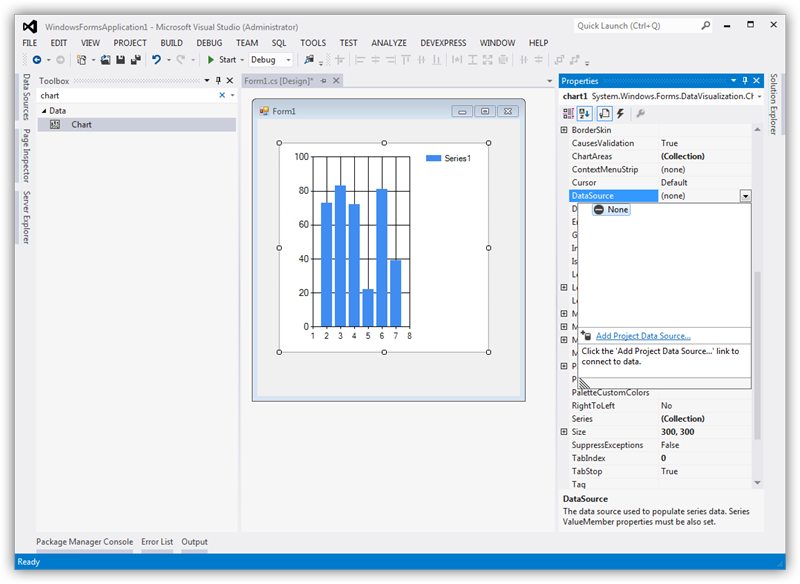Discover how a bimodal integration strategy can address the major data management challenges facing your organization today.
Get the Report →DataBind Charts to SQL Analysis Services Data
Use the standard ADO.NET procedures for databinding to provide bidirectional access to SQL Analysis Services data from controls in the Visual Studio toolbox. This article demonstrates a graphical approach using wizards in Visual Studio, as well as how to databind with only a few lines of code.
DataBinding facilitates two-way interaction with data through UI controls. Using the CData ADO.NET Provider for SQL Analysis Services streamlines the process of binding SQL Analysis Services data to Windows Forms and Web controls within Visual Studio. In this article, we will demonstrate using wizards to establish a binding between SQL Analysis Services data and a chart that dynamically updates. Additionally, the code walk-through section will guide you through the creation of a chart using just 10 lines of code.
DataBind to a Chart
DataBinding consists of three steps: Instantiate the control, configure the data source, and databind.
Configure the Connection and Select Database Objects
To create a chart control and establish a connection to SQL Analysis Services, follow the steps outlined below using the Data Source Configuration Wizard. Within the wizard, you'll have the option to choose the specific SQL Analysis Services entities you wish to bind to.
- In a Windows Forms project, drag and drop a Chart control from the toolbox to the form. In the Data section of the Chart properties, select DataSource and then select Add Project Data Source from the menu.
![Add a data source to be bound to the chart.]()
- In the Data Source Configuration Wizard that appears, select Database -> Dataset.
- In the Choose Your Data Connection step, click New Connection.
In the Add Connection dialog, click Change to select the CData SQL Analysis Services Data Source.
Below is a typical connection string:
User=myuseraccount;Password=mypassword;URL=http://localhost/OLAP/msmdpump.dll;To connect, provide authentication and set the Url property to a valid SQL Server Analysis Services endpoint. You can connect to SQL Server Analysis Services instances hosted over HTTP with XMLA access. See the Microsoft documentation to configure HTTP access to SQL Server Analysis Services.
To secure connections and authenticate, set the corresponding connection properties, below. The data provider supports the major authentication schemes, including HTTP and Windows, as well as SSL/TLS.
-
HTTP Authentication
Set AuthScheme to "Basic" or "Digest" and set User and Password. Specify other authentication values in CustomHeaders.
-
Windows (NTLM)
Set the Windows User and Password and set AuthScheme to "NTLM".
-
Kerberos and Kerberos Delegation
To authenticate with Kerberos, set AuthScheme to NEGOTIATE. To use Kerberos delegation, set AuthScheme to KERBEROSDELEGATION. If needed, provide the User, Password, and KerberosSPN. By default, the data provider attempts to communicate with the SPN at the specified Url.
-
SSL/TLS:
By default, the data provider attempts to negotiate SSL/TLS by checking the server's certificate against the system's trusted certificate store. To specify another certificate, see the SSLServerCert property for the available formats.
You can then access any cube as a relational table: When you connect the data provider retrieves SSAS metadata and dynamically updates the table schemas. Instead of retrieving metadata every connection, you can set the CacheLocation property to automatically cache to a simple file-based store.
See the Getting Started section of the CData documentation, under Retrieving Analysis Services Data, to execute SQL-92 queries to the cubes.
When you configure the connection, you may also want to set the Max Rows connection property. This will limit the number of rows returned, which is especially helpful for improving performance when designing reports and visualizations.
![Connection properties for the selected data source in the Add Connection dialog. (Salesforce is shown.)]()
-
HTTP Authentication
- Choose the database objects you want to work with. This example uses the Adventure_Works table.
![Select database objects. (Salesforce is shown.)]()
DataBind
After adding the data source and selecting database objects, you can bind the objects to the chart. This example assigns the x-axis to Fiscal_Year and the y-axis to Sales_Amount.
- In the Chart properties, click the button in the Series property to open the Series Collection Editor.
- In the Series properties, select the columns you want for the x- and y-axes: Select columns from the menu in the XValueMember and YValueMember properties.

The chart is now databound to the SQL Analysis Services data. Run the chart to display the current data.

Code Walk-through
DataBinding to SQL Analysis Services data requires only a few lines of code and can be completed in three easy steps.
- Connect to SQL Analysis Services.
- Create the SSASDataAdapter to execute the query and create a DataSet to be filled with its results.
- DataBind the result set to the chart.
Below is the complete code:
SSASConnection conn = new SSASConnection("User=myuseraccount;Password=mypassword;URL=http://localhost/OLAP/msmdpump.dll;");
SSASCommand comm = new SSASCommand("SELECT Fiscal_Year, Sales_Amount FROM Adventure_Works", conn);
SSASDataAdapter da = new SSASDataAdapter(comm);
DataSet dataset = new DataSet();
da.Fill(dataset);
chart1.DataSource = dataset;
chart1.Series[0].XValueMember = "Fiscal_Year";
chart1.Series[0].YValueMembers = "Sales_Amount";
// Insert code for additional chart formatting here.
chart1.DataBind();









